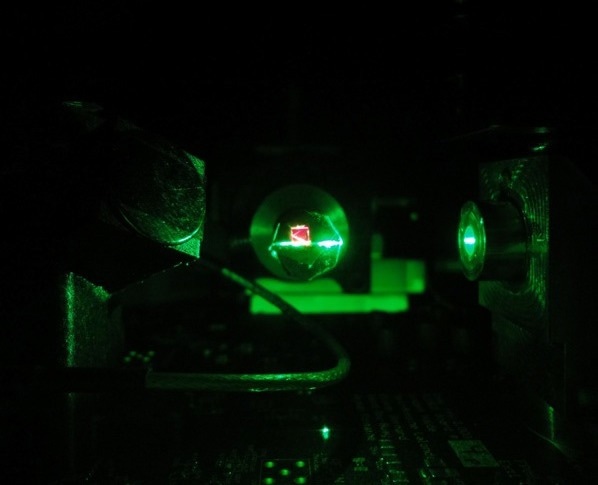Sponsored by Element SixReviewed by Emily MageeJul 29 2024
A startup company called SBQuantum (SBQ) is attempting to revolutionise navigation in locations where GPS is unavailable. The business creates and markets diamond-based quantum magnetometers for industrial and academic uses, particularly in autonomous vehicles.
Its two objectives are to increase navigation systems’ precision and dependability and to revolutionize magnetic anomaly detection by identifying flaws with improved accuracy in covert environmental structures more precisely. In difficult and complex conditions like those seen in cities and other uncharted extreme areas, this technology will have the biggest impact.

Image Credit: Element Six
Without Element Six, we simply would not have been able to make our magnetometer operate.
David Roy-Guay, CEO, SBQuantum Inc.
Target Applications
The entire service solution that SBQ is creating combines a sensor with a client-specific dashboard and can be used for navigation and anomaly detection.
Navigation
- Current GPS systems operate by connecting to satellites. When high-precision geolocation is necessary, the devices may employ supplemental signals like real-time kinematic signals (RTK), which are greatly influenced by their surroundings.
- GPS systems may be supplemented with very accurate magnetometers, which rely on the direction, strength, or relative change of the Earth’s magnetic field at a specific place, to offer the most exact location, altitude, and heading information.
However, huge metallic structures, such as skyscrapers, might cause iincreased nterference. Due to the unique magnetic field line profiles in polar regions, such as the Arctic, it is impossible to launch these systems independently, which frequently leads to the loss or damage of priceless equipment.
- Numerous situations, such as underground or underwater, are inaccessible to GPS. High-precision magnetometers are used by autonomous vehicles, including delivery drones, to navigate in these more challenging GPS-disabled environments. Current solutions have a natural tendency to drift, which reduces navigational accuracy.
Anomaly Detection
- Current magnetometers are easily distorted by moving metallic objects and have a limited grasp of their surroundings. For example, while doing a magnetic survey, it would be necessary to understand whether a defect has been found or if the automobile that just drove by has affected the signal.
- Several existing competing technologies try to do this, but each has drawbacks of its own. For instance, using a current system would make it difficult to tell if a crack is found in an underwater pipe or if the gadget has turned and the user is now experiencing the effect of the vehicle it is on.
Element Six is proud to help, nurture and support exciting new opportunities that seek to explore cutting-edge quantum applications in order to solve real-world challenges.
Dr Matthew Markham, Head of Quantum Technologies, Element Six
Quantum-Based Solutions
To address these issues, SBQ is creating diamond-based quantum magnetometers that use award-winning synthetic diamond pioneered by Element Six as a component of the quantum sensor.
- To obtain a more precise understanding of a vehicle’s orientation within its environment, the navigation systems will use vector-magnetic-field data from a diamond-based magnetometer. This will increase the accuracy of orientation and direction information and enable navigation in extreme conditions.
- Diamond-based devices’ increased sensitivity allows for the creation of cost estimates for anomaly surveys that are more accurate, thanks to a better understanding of the location and extent of faults.
- Diamond-based quantum devices provide an exceptional mix of low power consumption, drift suppression, high precision, and tensor gradiometry in one small, portable device form. Due to this combination, the potential for geological surveys and undersea pipe detection is expanded, putting SBQ’s quantum magnetometers apart from previous technologies.
Why Single Crystal Diamond?
A key supermaterial in applications that make use of quantum mechanics is diamond. Nitrogen vacancies (NV), a specific type of defect in diamond, have controlled quantum characteristics that make them behave like lone atoms at room temperature.
The quantum features of these atom-like diamond flaws may be controlled at room temperature, negating the need for a pricey and cumbersome cryogenic cooling apparatus.
Because the NV defect’s quantum properties are so sensitive to magnetic fields, NV in diamond is the perfect material for highly sensitive magnetometers diamond can be utilized to assess the direction of the field, in addition to delivery improved great sensitivity.
Diamond is an excellent choice as a very precise sensor to support GPS-deniced navigation owing to the combination of these features.
- Diamond-based magnetometers have internal calibration provided by fundamental physical constants, making them consistent.
- Chemical vapuor deposition (CVD) NV diamonds offer a uniform distribution of nitrogen-vacancy defects throughout the material
- Element Six is a world-leader in the production of synthetic diamond solutions with proven scale and reproducibility.
- Diamond quantum magnetometers have several advantages over currently available commercially available devices, including room-temperature operation, a large bandwidth, high sensitivity, and vector capability. These advantages make them suitable for many applications, including drones, underground mining vehicles, and autonomous underwater vehicles.
Element Six and SBQ
Element Six comprehends and appreciates the value of assisting and working alongside emerging, innovative groups in this space.
Element Six has been supportive and enthusiastic about the projects we have been doing from the very start.
David Roy-Guay, CEO, SBQuantum
Element Six and SBQ have collaborated since SBQ’s founding, having first met at the UK’s annual Quantum Showcase event in 2018. The first diamond samples needed by SBQ to create the prototype diamond-based quantum magnetometers were provided by Element Six along with:
- A variety of high-quality diamond materials with various requirements for prototyping and maximizing application possibilities
- Expert support to ensure the success of R&D endeavours
- Cooperation, direction, and assistance to advance new diamond-enabled advances

This information has been sourced, reviewed and adapted from materials provided by Element Six.
For more information on this source, please visit Element Six.